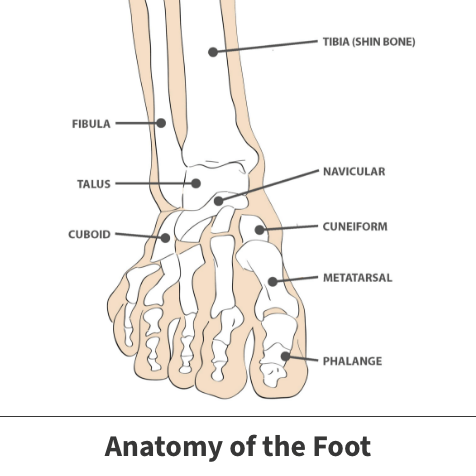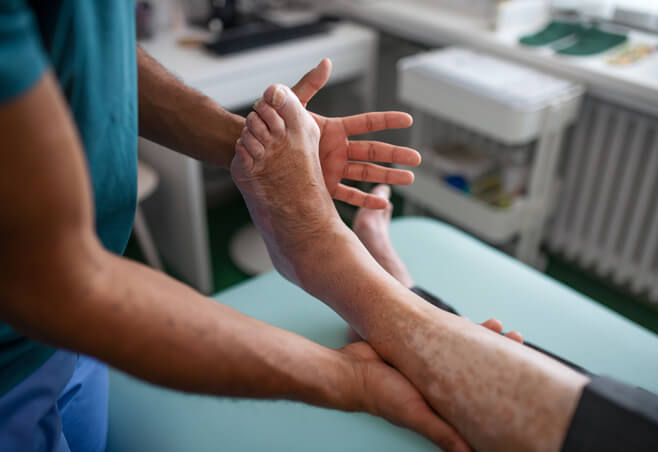Anatomy

The big toe consists of two joints: the metatarsophalangeal (MTP) joint and the interphalangeal joint. The interphalangeal joint is located in the middle of the toe. The MTP joint is the largest of the two and is found where the first long bone of the foot (metatarsal) meets the first bone of the toe (phalanx).
About
When the bones that make up the MTP joint fall out of alignment, the MTP joint gets larger, resulting in inflammation. Specifically, this occurs when the metatarsal bone shifts toward the outside of the foot while the phalanx angles toward the second toe. This inflammation is known as a bunion (hallux valgus). Several factors can increase the risk of getting one.
Risk factors of getting bunions:
- Footwear – Wearing shoes that force the toes into an unnatural position.
- Health condition – Having either an inflammatory condition such as rheumatoid arthritis, or a neuromuscular condition, such as polio.
- Hereditary – Can be developed hereditarily due to both foot shape and structure.
Bunions occur over time and are not an impact injury. Children are also at risk of developing them, but adults are most commonly affected. Ones that occur in young people are called adolescent bunions.

Symptoms
The symptoms may include:
- Visible bump on the inside of the foot with a callus or corn
- Pain and tenderness
- Redness
- Inflammation
- Hardened skin on bottom of foot
- Stiffness and restricted motion in the big toe
- Difficulty walking
Diagnosis
Your Florida Orthopaedic Institute physician will ask about your symptoms, general health, and medical history and examine your foot. An x-ray will also be ordered to check the alignment of your toes and check for damage to the MTP joint. Since the alignment of the foot changes when you stand or sit, the x-rays will be taken both while sitting and standing. These x-rays will help show your physician how severe your bunion is, and how best to correct it.
Treatment
Unfortunately, they can only be removed surgically. But nonsurgical treatments can be used to help reduce symptoms. Surgery is only recommended if nonsurgical treatments are unsuccessful or if it is severe.
Nonsurgical treatments
Bunions are typically treated nonsurgically. While it itself cannot go away without surgery, non-surgical treatments can help reduce pain while preventing it from getting worse. These treatments include:
- Ice applied several times a day for 20 minutes at a time can significantly reduce swelling.
- Nonsteroidal anti-inflammatory medications such as Advil and Motrin (ibuprofen) and Aleve (naproxen) can help reduce pain and swelling.
- Changing footwear is highly recommended because shoes that do not fit correctly will squeeze your toes and cause pain. Your Florida Orthopaedic Institute physician will give you information on the proper footwear fit for you.
- Padding can help cushion the painful area of it, decreasing pain.
- Depending on the severity, over-the-counter or custom-made shoe inserts (orthotics), splints, or toe spacers may all be used to help ease pressure and reduce pain.
Surgical procedures and treatments
Surgery is only necessary if nonsurgical treatments were unsuccessful or if the bunion is severe. There are several different bunions treatment surgical procedures used to correct them including bunionectomy. All procedures focus on realigning bone, ligaments, tendons, and nerves which will allow for the big toe to be brought back to its correct position.
In the cases of an adolescent bunion, surgery is not recommended because there is a strong chance it will return. Surgery may be recommended if it causes extreme pain that does not go away after nonsurgical treatments.
Recovery
After surgery, a surgical boot or cast will need to be worn to protect your foot. A brace will then need to be worn to support the foot during the healing processes. Surgery recovery takes approximately six to eight weeks, but a full recovery can take an average of four to six months.
Videos
Related specialties
- Achilles Calcific Tendinitis
- Achilles Tendon Rupture
- Achilles Tendonitis
- Ankle Fracture Surgery
- Ankle Fractures (Broken Ankle)
- Ankle Fusion Surgery
- Arthroscopic Articular Cartilage Repair
- Arthroscopy of the Ankle
- Charcot Joint
- Common Foot Fractures in Athletes
- Foot Stress Fractures
- Hallux Rigidus Surgery - Cheilectomy
- Hammer Toe
- High Ankle Sprain (Syndesmosis Ligament Injury)
- Intraarticular Calcaneal Fracture
- Lisfranc Injuries
- Mallet, Hammer & Claw Toes
- Metatarsalgia
- Neuromas (Foot)
- Plantar Fasciitis
- Sprained Ankle
- Total Ankle Replacement
- Turf Toe
